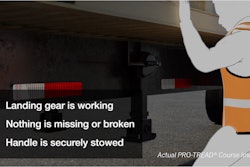
 Bert Mayo, vice president of risk solutions for insurance broker TrueNorth Companies, predicted that proposed HOS changes will become law by spring of 2020.
Bert Mayo, vice president of risk solutions for insurance broker TrueNorth Companies, predicted that proposed HOS changes will become law by spring of 2020.“Nuclear” verdicts by juries in the last decade will cause insurance premiums to go up between 20 and 25 percent when carriers renew their policies in 2020, “even if they are doing an outstanding job,” a speaker told fleets at the CCJ Solutions Summit, Nov. 19 in Scottsdale, Ariz.
Insurance companies in the trucking market have been running 120 percent loss ratios for the last seven to eight years, and “it is going to be a really hard year for renewals,” said Bert Mayo, vice president of risk solutions for insurance broker TrueNorth Companies.
To be able to afford insurance, carriers may have no choice but raise deductibles and lower liability coverages. For example, they might raise their deductibles from $50,000 to $100,000, and lower their coverages from $5 million to $3 million per incident. “I don’t mean to be the bearer of bad news, but that it is what’s out there.”
The good news is that the Trump administration will move quickly to make the proposed changes to hours-of-service become law, he predicted. Mayo doesn’t have inside information, but he believes the Federal Motor Carrier Administration will publish a final rule by next spring, and possibly as early as January 2020.
“I am hoping this is a way [the administration] will give back to the industry because of ELDs,” he said.
Mayo outlined reasons why the proposed HOS rule will likely become law. Besides the obvious political reasons for “voter grab,” the HOS proposals gives fleets and drivers more flexibility without the FMCSA compromising safety, he explained. The proposed changes would:
- Extend the radius of the short haul exemption from 100 to 150 air miles. Currently, only fleets that operate within a radius of 100 air miles are not required to keep a record of duty status (RODS) or take a 30-minute break.
- Extend the maximum on-duty limit of short haul fleets to 14 hours, up from 12 hours.
- Increase the maximum 14-hour on duty period by two hours to allow for up to 13 hours of drive time and up to 16 hours of on-duty for “adverse conditions,” meaning for unforeseen events such as weather.
- Split up the 10-hour off-duty rest period, either by taking eight or seven hours in the sleeper berth, and then spending two or three hours in off duty status. The off-duty breaks would not count towards a driver’s 14-hour on-duty window.
- Allow drivers to satisfy the 30-minute break requirement by using off-duty status. Drivers can extend a break for up to three hours without counting it as on-duty.
Mayo said the last two — the split duty for sleeper berth and 30 minute break — will have the greatest impact on fleets and driver productivity. He also was enthusiastic over the short haul exemption. As an insurance broker, he deals with lot of drayage operations. A 150 air-mile radius and 14 hours of on-duty time “is going to make drivers more efficient, productive, equipment utilization go up,” he said.
He also addressed two gray areas in the HOS rule that motor carriers will have to use judiciously: adverse conditions and personal conveyance. “With all the tools we have at our disposal,” such as ELDs, mapping data and other technologies, “we know what is happening when and where.” It would be difficult for a carrier or driver to claim, for example, that using adverse conditions is justified (i.e. unforeseen) when traveling through a January snowstorm in Colorado on I-70.
In general, he advised fleets to not let drivers spend more than one hour in personal conveyance to avoid potential logbook violations.












